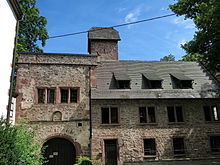Steinegg Castle (Neuhausen)
| Steinegg Castle | |
|---|---|
| Creation time : | 15th century |
| Castle type : | Location |
| Conservation status: | Remnants in newer parts |
| Place: | Neuhausen -steinegg |
| Geographical location | 48 ° 48 '54.7 " N , 8 ° 47' 14.6" E |
| Height: | 410 m above sea level NN |
The Steinegg Castle is a late medieval castle in the Steinegg of the same name, a district of the Neuhausen municipality , in the Enzkreis in Baden-Württemberg , Germany . The castle now serves as a leisure home for the Protestant parish in Pforzheim .
history
In the high Middle Ages, the hilltop castle Steinegg was located on the terraced knoll behind today's Steinegg Castle . Adalbert von Steinegg, a ministerial of the Counts of Calw , who was first mentioned in 1150, is considered to have built it . The hill fort came with the associated lordship in 1324 to Wolf I. vom Stain . As a result of the overthrow of the Schleglerbund , the estate and the castle were sold to Diether V von Gemmingen in 1407 , who moved into the Schleglerschloss . His son of the same name Diether (1398–1478) built a new castle under the old hilltop castle, of which only the foundations are preserved today. He rounded off the Gemmingen property in the Biet with the villages of Steinegg, Tiefenbronn, Mühlhausen, Hamberg, Schellbronn, Hohenwart, Lehningen and Neuhausen as well as Wald im Hagenschieß and the castle became the administrative center of this rule, which Diether soon gave to the margrave of Baden for political reasons . Diether was followed by his son Otto von Gemmingen († 1517), who left only daughters. They sold the property to Otto's nephews Dietrich VIII of Gemmingen († 1542) and Otto von Gemmingen (1475–1558), who shared their property in 1519, with Steinegg coming to Dietrich VIII. At that time, a castle chapel was built in 1520 .
The family of the lords of Gemmingen-Steinegg continued to branch out in the 16th century, so that manor houses were also built in Tiefenbronn and Mühlhausen around 1540, while the castle in Steinegg came to Dietrich's VIII son Eitel Dietrich von Gemmingen (1513–1568) . In the late 16th century, the castle was expanded in the Renaissance style by his son Hans Pleikard von Gemmingen (1546–1603). The division of rule also resulted in an upgrading of the parishes in the Gemmingen villages, so that with the expansion of Steinegg Castle, the parish church of Neuhausen was expanded, in whose choir lord Hans Pleickard had an important grave monument erected around 1600.
The childless Hans Pleickard was succeeded by his distant relative Karl Dietrich von Gemmingen (1583–1629) and then his son Eitel Dietrich von Gemmingen (1629–1689). The castle survived the Thirty Years' War without major damage, not least thanks to high contributions from the lords of the castle. Even in the Palatinate War of Succession , Eitel Dietrich's son Karl Dietrich von Gemmingen (1658–1699) initially averted destruction by paying Sauvegarden . However, when he was traveling in 1694, the castle burned down and was rebuilt in the course of 1695.
The expansion of the castle chapel and the Hamberg forest chapel, which was built on a rock near the castle in the forest, goes back to Karl Dietrich's son, Karl Dietrich Anton von Gemmingen (1694–1745). After his childless death, Johann Dietrich von Gemmingen (1716–1778) took over as lord of the castle . He brought the distantly related Maria Joseph Heinrich Dionysius von Gemmingen (1714–1796) to his home in Steinegg. Dionys' fortune had been embezzled by a guardian, later Dionys was arrested for assault in Pforzheim and then tried unsuccessfully to earn a living on the Neuhausen parish. Dionys was looked after at Steinegg until his death in 1796 and his descendants later came into the possession of the castle after Johann Dietrich's son Franz died in 1797 due to an unfortunate fall without male descendants. The last resident of the castle was Dionys' grandson Julius von Gemmingen-Steinegg (1774–1842), who married Franz's daughter Anna Maria and converted from Catholicism to the Evangelical Church in 1823 as part of Alois Henhöfer's entourage . In 1835 he handed over the property in Steinegg to his sons Eduard and Gustav and moved to Stuttgart. The sons sold the castle to the state of Baden in 1839 . The state intended to set up a brewery or spinning mill at the facility. However, this displeased Eduard von Gemmingen-Steinegg that he bought the castle back in 1840. At his order, the roofs of the castle were then covered, whereupon the complex fell into ruin .
From 1928 on, Freiin St. Clair von Gemmingen-Steinegg , a great-granddaughter of Julius von Gemmingen, campaigned for the preservation of the ruins and soon also for the reconstruction of the building. After her death in 1951, Irmgard von Bistram , another descendant of Julius von Gemmingen, continued the reconstruction. In 1958 the Protestant parish of Pforzheim came into possession of the complex via a hereditary building contract. With its own resources, state grants and donations from the von Gemmingen family, the castle was finally largely rebuilt and converted into a leisure home.
literature
- Evang. Parish of Pforzheim (ed.): Steingg Castle. Youth leisure home of the Evangelical Church Community Pforzheim , Pforzheim 1979
- Friedrich-Wilhelm Krahe: Castles of the German Middle Ages. Floor plan lexicon . Flechsig, Würzburg 2000. ISBN 3-88189-360-1
- Georg F. Kost: Steingg Castle - The end of an imperial rule , in: Der Enzkreis, year book 91/92 , ed. from the district office of Enzkreis, pp. 199–203.
- Heinrich Leicht: Neuhausen under Gemmingsch rule , in: Community Neuhausen (Hrsg.): Neuhausen once and now. Volume I , Horb 2001, pp. 52-62.

